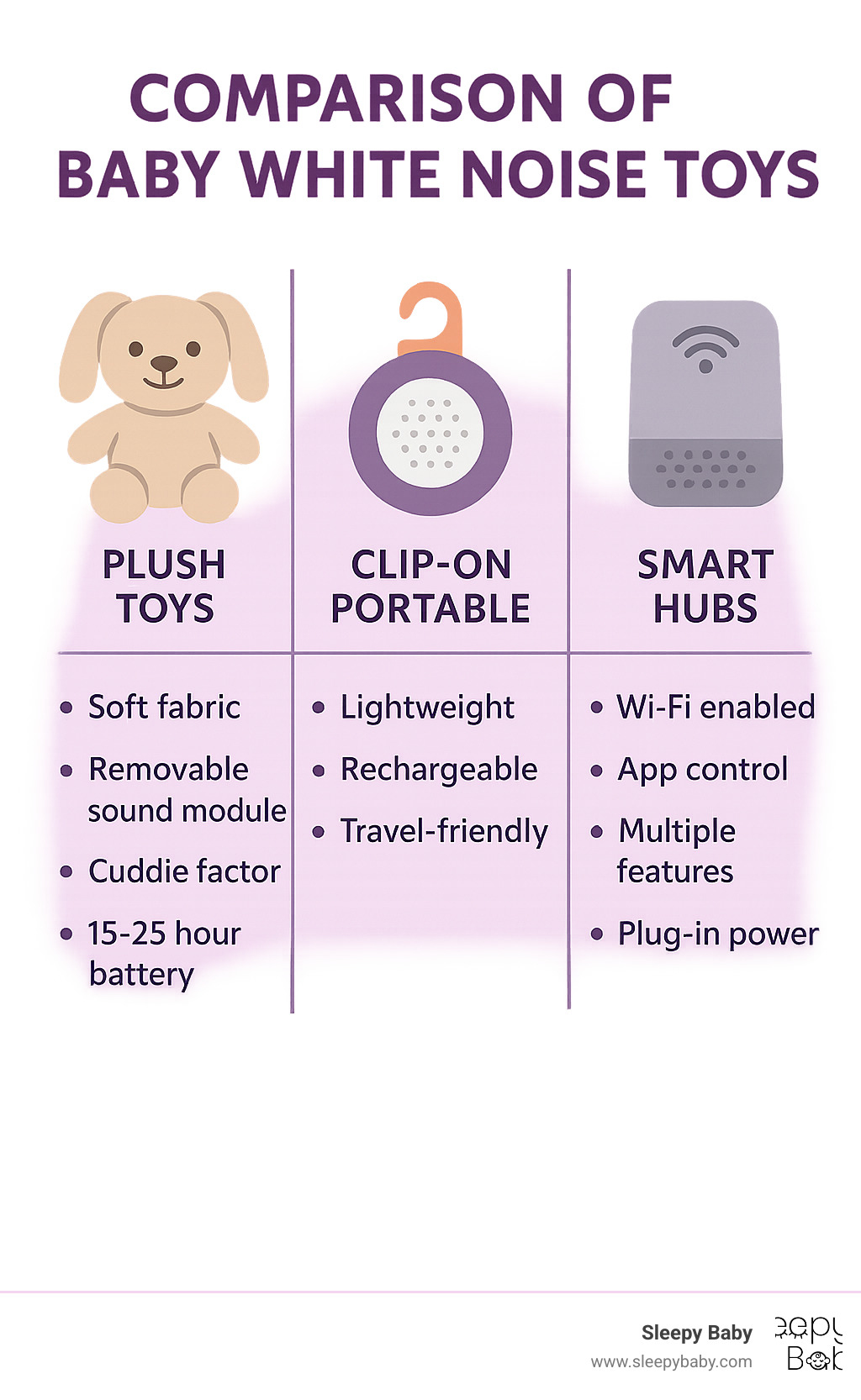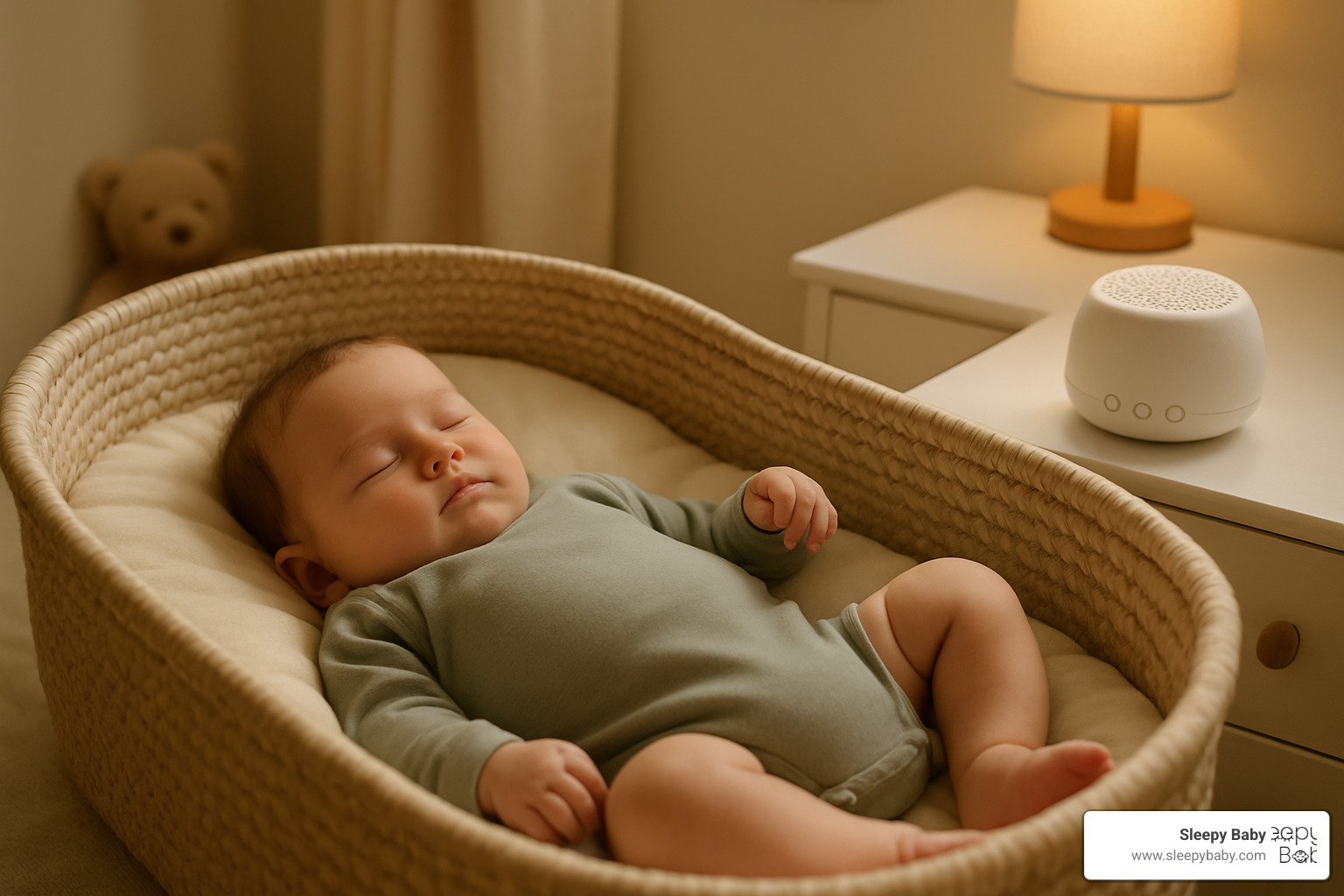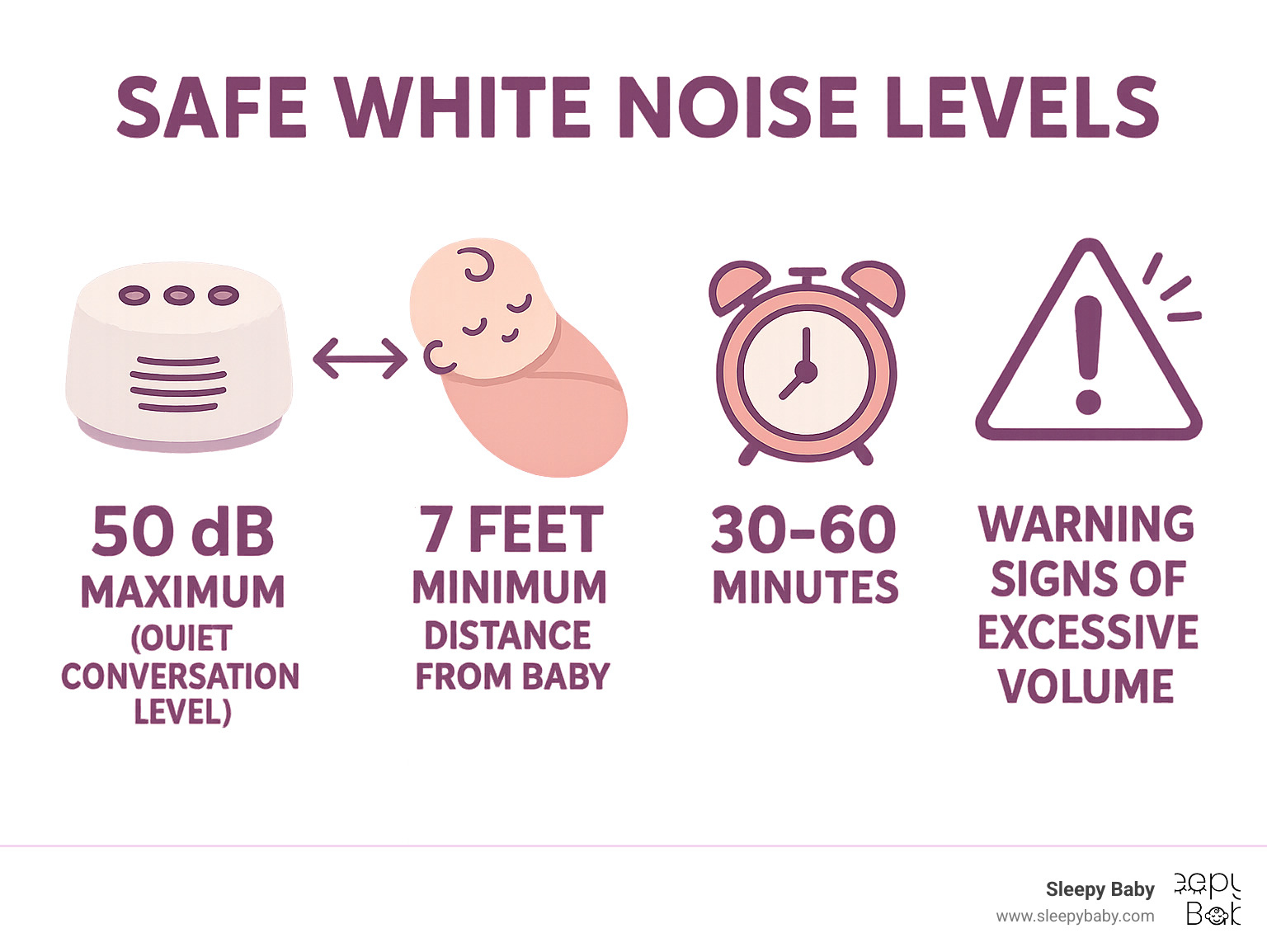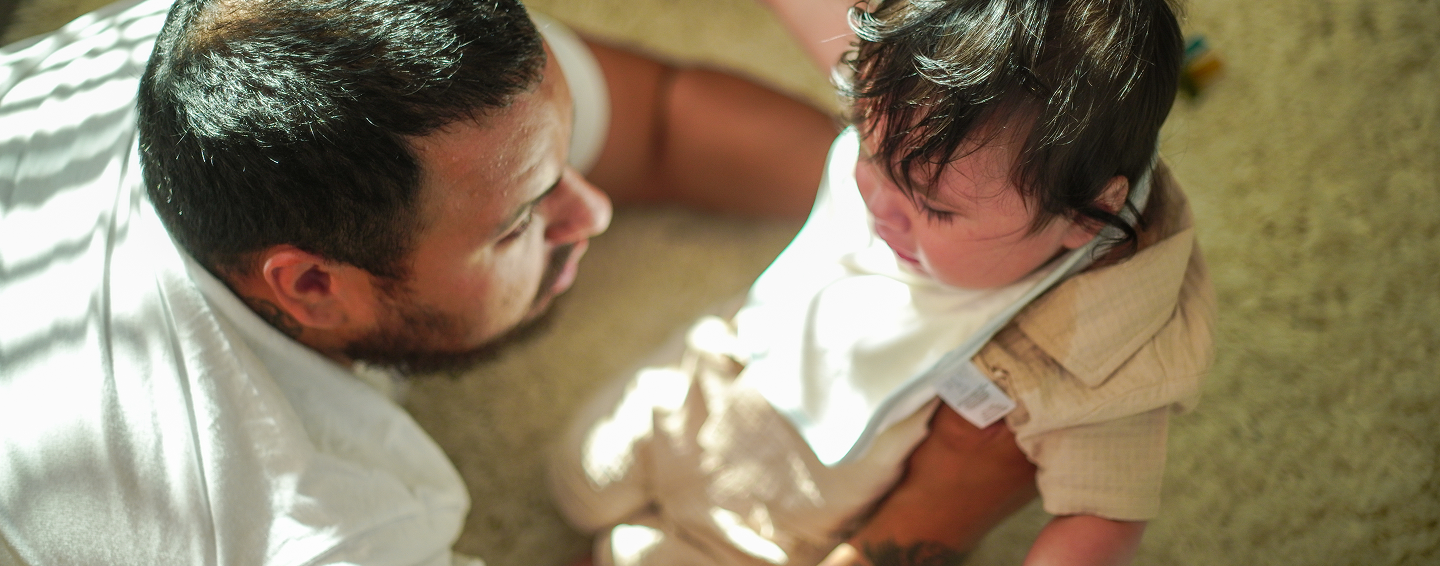Why Sleep-Deprived Parents Are Turning to White Noise Toys
A baby white noise toy combines the soothing power of consistent sound with the comfort of a cuddly companion, helping infants fall asleep faster and stay asleep longer. These specialized toys use gentle, rhythmic sounds that mimic the womb environment to calm fussy babies and mask disruptive household noises.
Top baby white noise toy features to look for:
- Timer settings (15-60 minutes) to prevent all-night play
- Volume control with safe decibel levels (under 50 dB)
- Portable design with clips or straps for strollers and car seats
- Washable covers for easy cleaning
- Auto shut-off to preserve battery life
- Multiple sound options including heartbeat, ocean waves, and pure white noise
The research shows impressive results. In one study, 80% of newborns fell asleep within five minutes of white noise exposure. Popular models like the Baby Einstein Sea Dreams Soother have over 17,000 customer ratings averaging 4.5 stars, with parents praising their effectiveness for establishing bedtime routines.
These toys work by creating consistent background sound that masks sudden noises like doors closing or siblings playing. The steady whoosh mimics the sounds babies heard in the womb, triggering their natural calming reflex.
Safety is crucial. The American Academy of Pediatrics recommends keeping white noise machines at least seven feet away from babies and limiting volume to 50 decibels - about as loud as a quiet conversation.
I'm Gary Harutyunyan, and after struggling with my own newborn's sleep challenges, I became passionate about finding effective solutions for exhausted parents. My experience developing the Sleepy Baby rhythmic patting device taught me that the right baby white noise toy can be a game-changer for family rest and bonding.

Why White Noise Works for Babies
If you've ever wondered why your little one seems to sleep better with that gentle whooshing sound, you're not alone. The secret lies in something called auditory masking - essentially, your baby white noise toy creates a consistent sound barrier that covers up those sudden household noises that love to wake sleeping babies.
Think about it from your baby's perspective. For nine months, they lived in a surprisingly noisy environment. The womb isn't the quiet sanctuary many parents imagine - it's filled with the constant womb-like whoosh of blood flow, your heartbeat, and even digestive sounds. Some researchers say it's as loud as a vacuum cleaner in there!
When babies enter our relatively quiet world, that sudden silence can actually feel unsettling. A baby white noise toy helps bridge that gap by recreating those familiar, comforting sounds they knew before birth.
The magic really happens during your baby's sleep cycles. Babies spend more time in lighter sleep phases than adults, making them incredibly sensitive to every creaking floorboard or closing door. White noise acts like a protective sound bubble, helping them glide smoothly from one sleep cycle to the next without fully waking up.
This consistent background sound triggers what's known as a calming reflex - your baby's natural response to familiar, rhythmic sounds. It's the same reason why shushing works so well, just automated and consistent.
Beyond immediate sleep benefits, there are genuine developmental benefits too. Better sleep means better brain development, improved mood regulation, and happier parents - which creates a positive cycle for the whole family.
More info about Womb Heartbeat sounds
The Science in a Nutshell
Here's where it gets really interesting. Research shows that white noise actually helps babies' brains produce more delta waves - those special brain waves that signal deep, restorative sleep. When babies reach this deeper sleep state, they're much less likely to wake from minor disturbances.
The startle suppression effect is particularly powerful for newborns. You know that sudden arm-flinging motion when your baby gets startled? That's the Moro reflex, and it's completely normal - but it can also wake your baby from an otherwise peaceful sleep. White noise helps dampen this reflex response.
According to research published in the Archives of Disease in Childhood, 80% of newborns fell asleep within five minutes when exposed to white noise, compared to only 25% in the control group. This demonstrates the powerful effect of consistent sound on infant sleep patterns.
Key Safety Guidelines
While white noise can be incredibly helpful, safety always comes first. The American Academy of Pediatrics has established clear guidelines that every parent should follow.
Decibel limits are crucial - never exceed 50 decibels, which is about as loud as gentle rainfall or a quiet conversation. Your baby's hearing is still developing, and exposure to louder sounds could cause damage.
The 7-foot rule is a helpful guideline for most white noise toys, as it helps keep sound levels gentle and safe for your baby. However, some toys are designed to deliver calming white noise at very low, safe decibel levels—even when placed closer to your baby’s chest. Always check your device’s volume settings and safety recommendations to ensure a soothing, secure sleep environment.
Timer use isn't just recommended - it's essential. Continuous white noise throughout the night isn't necessary and can lead to dependency. Most babies benefit from 30-60 minutes of white noise, giving them time to settle into deep sleep before the sound gradually fades.
Always seek pediatrician advice before introducing any new sleep aid, especially if your baby has existing hearing concerns or other medical conditions.
Best Baby White Noise Toy Roundup
When you're standing in the baby store aisle (or scrolling through endless online options at 2 AM), the sheer variety of baby white noise toy choices can feel overwhelming. The market breaks down into three main categories, each designed for different parenting situations.

Plush "baby white noise toy" Picks
There's something magical about a baby white noise toy that your little one can actually snuggle with. These soft companions become much more than just sound machines - they're comfort objects that can help your baby feel secure even when you're not in the room.
The best plush models feature soft, baby-safe fabrics that can withstand countless cuddles and the occasional spit-up incident. What really sets quality options apart is the removable sound module. This genius feature means you can toss the plush part in the washing machine while keeping the electronics safe and dry.
The cuddle factor shouldn't be underestimated. Many parents tell me their toddlers still sleep with these toys years later, long after they've outgrown needing white noise. Auto-shutoff is absolutely essential in plush models, with the best ones offering flexible timer settings - usually 15, 30, and 45 minutes.
Clip-On "baby white noise toy" for On-the-Go
If your family is always on the move, clip-on models are absolute lifesavers. These compact devices excel at maintaining sleep routines whether you're grocery shopping, visiting grandparents, or traveling.
The magic is in their portable design. Quality models come with stroller straps and sturdy clips that attach securely to car seats, strollers, and travel cribs. Rechargeable battery life becomes crucial when you're away from home, with top-performing units offering an impressive 20-50 hours of continuous use. Many now feature USB-C charging for convenience.
Smart Hub Sound Machines
For parents who love technology, smart hub models represent the premium tier of white noise solutions. These Wi-Fi control enabled devices connect to smartphone apps, giving you incredible flexibility and control.
App routines are where these devices really shine. You can program automatic sequences and control everything remotely without entering the nursery. Sleep-trainer lights add a visual element that grows with your child, projecting gentle, color-changing lights that indicate sleep time versus wake time.
Multi-Sensory Projectors
Multi-sensory projectors combine white noise with gentle light shows. Ocean lights projectors are particularly mesmerizing, combining visual waves with coordinated sounds. The key is gentle motion that calms rather than stimulates, using slow, predictable patterns.
Most projector models come with extensive lullaby libraries - often 20+ songs and sounds. This variety prevents habituation, where babies become less responsive to repeated stimuli.

How to Choose the Right Toy
Finding the perfect baby white noise toy feels overwhelming when you're already sleep-deprived, but focusing on a few key factors will guide you to the right choice for your family.
Volume range should top your priority list. Your ideal toy needs at least 3-5 volume levels, with the loudest setting staying safely under 50 decibels. Some thoughtful manufacturers include volume limiters that prevent accidental cranking up.
The sound library makes a bigger difference than you might expect. While basic models offer 4-8 sounds, premium options provide 20-30 different choices including white noise, pink noise, nature sounds, and lullabies. Every baby has preferences - having variety means you can experiment to find your little one's personal favorite.
Battery versus plug-in power affects your daily routine more than you'd think. Battery models give you freedom to move between rooms and travel easily, but they need regular charging. Plug-in models provide reliable power but tie you to wall outlets. The sweet spot? Hybrid models that offer both options.
Don't underestimate portability needs. Look for lightweight options under 2 pounds with secure clips or straps. Durability becomes crucial once your baby finds they can grab, throw, and taste everything. Models with reinforced seams, child-safe materials, and protected sound modules will survive the inevitable toddler testing phase.
More info about Best Sleep Aids
Feature Checklist
Timer settings with multiple options (15, 30, 45, 60 minutes) plus continuous play give you flexibility for different sleep situations. The best models offer gradual fade-out timers that slowly reduce volume instead of abruptly cutting off.
Night-light hues matter if you're choosing a model with illumination. Warm red or amber colors support natural melatonin production, while bright white or blue lights can actually wake your baby up.
Washable covers aren't optional - they're essential. Look for covers that zip off easily and survive the washing machine. Child-safe materials should meet all infant toy safety standards. BPA-free plastics, lead-free electronics, and flame-retardant-free fabrics protect your baby's health.
Cry sensor technology in advanced models detects fussing and automatically restarts soothing sounds. This hands-free feature can save your sanity during those nights when every movement might wake a light sleeper.
Budget Breakdown
Entry level ($15-30) gets you basic plush toys with simple sound modules. Expect 4-8 sounds, basic timers, and 6-12 hour battery life. These work perfectly for testing whether your baby responds well to white noise.
Mid-range ($30-60) offers the sweet spot for most families. You'll get longer battery life (15-25 hours), more sound options (10-15), better build quality, and washable covers. This range balances features with affordability.
Premium ($60-120+) brings smart features, app control, cry sensors, projection lights, and superior audio quality. Worth considering if you plan to use the device for multiple children.
When calculating value versus longevity, consider potential use across multiple babies. Quality baby white noise toys often become treasured family hand-me-downs.
Using & Maintaining a White Noise Toy
Getting the most out of your baby white noise toy isn't just about turning it on and hoping for the best. Proper setup and care make all the difference between a helpful sleep aid and a frustrating gadget gathering dust.
Placement makes or breaks the experience. While the 7-foot rule from the American Academy of Pediatrics is a trusted guideline for most white noise toys, some specially designed sleep aids can safely deliver gentle white noise close to your baby’s chest at low, pediatrician-approved decibel levels. For standard toys, keep them on a dresser or attach clip-ons to the crib’s foot—never right by your baby’s head.
Weaving the toy into your bedtime routine creates powerful sleep associations. Start the sounds during that final diaper change or last feeding of the night. Your baby's brain will begin connecting the gentle whoosh with sleep time. Consistency is your secret weapon - babies thrive on predictable patterns.
Keeping things clean doesn't have to be complicated, but it does need to happen regularly. Remove those sound modules before tossing plush covers in the washing machine. Use gentle, fragrance-free detergent since baby skin is sensitive to perfumes and harsh chemicals.
For the electronic bits, a slightly damp cloth with mild soap works wonders. Never submerge the sound components in water. Weekly cleaning keeps things fresh, but clean immediately after any spit-up incidents.
Smart models need occasional firmware updates to keep running smoothly. Check your manufacturer's app monthly for improvements or new sound options.
Troubleshooting Common Issues
Battery drain is the most common complaint I hear from parents. If your toy suddenly needs charging every day instead of lasting a week, check for background apps on smart models. Reducing screen brightness and ensuring stable Wi-Fi connections prevents your device from working overtime.
Looping glitches usually happen when batteries run low or sound files get corrupted. The simple fix? Power off completely for 30 seconds, then restart fresh.
Some toys have volume reset issues after battery changes or updates. Keep a mental note of your preferred volume level so you can quickly readjust when needed.
Connection problems plague smart models when Wi-Fi signals weaken. If your nursery sits far from your router, consider a Wi-Fi extender.
When to Wean Off
Your baby won't need white noise forever. Most sleep experts suggest gradually reducing dependency between 6-12 months as babies develop stronger self-soothing abilities.
Newborns up to 6 months benefit most from consistent white noise since they're still adjusting to life outside the womb. From 6-12 months, you can start the gradual reduction process. After their first birthday, many babies sleep beautifully without constant audio support.
The gradual approach works better than going cold turkey. Reduce volume by one level every few days rather than eliminating the sound overnight. This gentle transition lets your baby adjust without sudden sleep disruptions.
Introducing alternate comfort strategies fills the gap as white noise fades. A soft blanket or small stuffed animal can become the new sleep association. Keep your bedtime routine consistent while slowly removing the audio component.

Frequently Asked Questions about Baby White Noise Toys
New parents often have concerns about using white noise safely and effectively. Let's address the most common questions we hear from families considering a baby white noise toy.
How loud should the toy be?
The golden rule for white noise volume comes straight from the American Academy of Pediatrics: keep it at or below 50 decibels. To help you picture this, 50 decibels sounds like gentle rainfall or two people having a quiet conversation across the room.
Here's a helpful comparison: normal conversation reaches about 60 decibels, while your vacuum cleaner roars at 75 decibels. Your baby white noise toy should never compete with regular household conversation.
Most quality white noise toys come with multiple volume settings for good reason. Start with the lowest level that still masks household sounds, then adjust up only if needed. A simple test: if you have to raise your voice to talk over the white noise, it's definitely too loud.
Your baby's ears are much more sensitive than yours. What feels comfortable to adult ears might overwhelm those tiny developing eardrums. When you're unsure, always choose the quieter option and watch how your baby responds.
Can white noise help with sleep training?
White noise can absolutely support your sleep training efforts, though it's not a magic wand that does all the work for you. Think of it as a helpful teammate rather than the star player.
The consistency of white noise creates what sleep experts call an "audio anchor." Your baby begins associating that familiar sound with sleep time, which can make the falling-asleep process smoother during those challenging first weeks of sleep training.
During the tougher moments of sleep training - when babies are learning new sleep patterns - white noise masks household sounds that might otherwise wake a baby who's just settling down. It also helps muffle crying sounds, which can be a blessing if you're worried about disturbing siblings or neighbors.
The key is avoiding over-dependence on the white noise. Your baby should learn to fall asleep with multiple comfort cues, not rely entirely on the sound machine. This way, they're not completely lost if the device isn't available.
Are these toys safe for newborn ears?
When used correctly, a baby white noise toy is perfectly safe for newborn ears. The secret lies in following those important safety guidelines we've discussed throughout this guide.
Interestingly, newborn hearing is actually less sensitive than adult hearing during the first few weeks of life. But here's the catch: their hearing develops rapidly. By 3-4 months, babies hear almost as well as adults, making proper volume control increasingly important as they grow.
This is why the 7-foot distance rule is so important. Placing most white noise toys at least seven feet from your baby helps ensure the sound is gentle enough for safe listening, while still providing soothing benefits. However, some newer white noise toys designed to rest on a baby's chest have been safety rated and can be appropriate to use in specific situations—always follow manufacturer guidelines and consult your pediatrician if unsure.
The timer function serves as another safety net. While white noise is generally safe, giving your baby regular breaks from constant sound exposure supports healthy auditory development. Those quiet periods are just as important as the soothing sounds.
Trust your instincts, but also trust the guidelines. If you notice your baby doesn't startle at loud sounds or doesn't seem to respond to your voice, contact your pediatrician right away. These could be signs of hearing issues that need professional attention.

Conclusion
Finding the perfect baby white noise toy isn't just about buying another baby gadget - it's about giving your entire family the gift of better sleep. When you find that sweet spot of consistent, soothing sounds that help your little one drift off peacefully, everything changes. Suddenly, bedtime becomes less of a battle and more of a gentle transition into dreamland.
The beauty of these devices lies in their simplicity. Whether you choose a soft plush companion that doubles as a cuddle buddy or invest in a high-tech smart hub with all the bells and whistles, the core principle remains the same: creating that womb-like environment that makes your baby feel safe and secure.
Safety isn't negotiable. Those 50-decibel volume limits and 7-foot distance guidelines aren't suggestions - they're your roadmap to using white noise responsibly. Your baby's developing ears deserve that extra care, and following these simple rules ensures you get all the sleep benefits without any worries.
The research speaks for itself. When 80% of newborns fall asleep within five minutes of hearing white noise, we're not talking about a placebo effect - we're seeing real science in action. That consistent whoosh mimics the sounds your baby knew before birth, triggering natural calming responses that help tiny bodies relax into sleep.
Every family's needs are different, and that's okay. Maybe you're always on the go and need a clip-on model for the stroller. Perhaps you love the idea of controlling everything from your phone with a smart device. Or maybe you just want something simple and reliable that works night after night without fuss. The right baby white noise toy is the one that fits seamlessly into your life and actually gets used.
At Sleepy Baby, we understand that soothing goes beyond just sound. That’s why our devices combine gentle, rhythmic patting with white noise delivered safely at your baby’s chest. Each product is thoroughly safety tested and proven safe and effective for newborns and up, offering hands-free comfort that mimics your reassuring touch—so you and your baby can rest easier.
Your journey to better family sleep starts with finding the right tools. Sweet dreams are waiting for both you and your little one.




